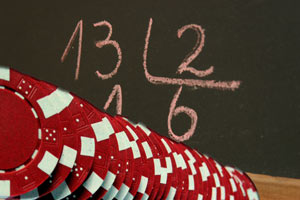Now we are going to discuss how you can use ICM to make decisions during a tournament, especially in the late stages. If you haven’t read the previous article “What is ICM” then it would be recommended to read this first, as some of the concepts here assume a basic understanding.
One of the most important things to understand when using ICM in tournament poker is the different between cEV (chip Expected Value) and $EV (money Expected Value). cEV is the amount of chips that you can expect to gain or lose from a play. $EV is the amount of tournament equity that you can expect to gain or lose from a play. Just because a play may be +cEV doesn't necessarily mean that it will be +$EV!!!
Chip Expected Value is like EV in cash games.
For example if you and your opponent both have 1000 chips and go all in preflop, with you holding AA and your opponent holding KK, you can expect to make approximately 800 chips from this call every time you make it (because you're roughly an 80% favourite to win the hand). So chip EV, as stated above is simply the amount of chips we gain on average by making a play.
Money EV is a slightly more advanced version, as you must calculate how much money you expect to gain in prize pool equity from each play you make in a tournament. For example, in the above case where we call and win 480 chips, this still applies of course. But we must put a monetary figure on how much more likely we are to win the tournament with those additional 480 chips.
Using ICMto make marginal or tough decisions
When faced with a tough decision it is obviously important for us to be able to work out whether a call will increase our overall equity. A good example for this is if we are in the BB with a hand like KJs and the small blind goes all in with a random hand. Here we are not super interested in how many chips we expect to gain by calling, but we are extremely interested in whether or not it increases our tournament equity.
Example Hand
In this example we are playing a $10, 10 man sit and go which has a standard pay-out structure of top 3 places (1st - $50, 2nd - $30 and 3rd - $20). The blinds are 100/200 and there are 4 players remaining:
(BB - HERO) Player A – 2,000
(SB) Player B – 2,000
(BTN) Player C – 3,000
(CO) Player D – 3,000
Players D and C both fold and then we are left with the same situation as we discussed above. Player B shoves into us and we have KJs in hearts. We know already that player B is very aggressive and in this situation will go all in with any two cards. There are 3 very important steps we must take before making a decision. The first is working out our equity versus his range, which we know is a random hand. Secondly we must consider the changes in prize pool equity for every situation (if we fold or call and win/lose). After we have done this we are ready to work out if our overall equity will increase by calling.
Working out our equity against a random hand is very easy thanks to programmes like PokerStove which will tell you within seconds of entering the information. Using this, I can tell you that our equity with KJs is 62.6% against a random hand. Meaning that 62.6% of the time our stack increases to 4,000 chips and 37.4% of the time we lose our chips and bubble the tournament.
For our next step we will need to use an ICM calculator again. We are going to calculate our changes in prize pool equity for all 3 scenarios – call and win, call and lose and fold.
Our equity if we call and win
(BB) Player A – 4,000 = $35.40 equity
(SB) Player B – 0 = $0 equity
(BTN) Player C – 3,000 = $32.30 equity
(CO) Player D – 3,000 = $32.30 equity
Our equity if we call and lose
(BB) Player A – 0 = $0 equity
(SB) Player B – 4,000 = $35.40 [equity
(BTN) Player C – 3,000 = $32.30 equity
(CO) Player D – 3,000 = $32.30 equity
Our equity if we fold (lose our 200 chip BB)
(BB) Player A – 1,800 = $20.20 equity
(SB) Player B – 2,200 = $23.40 equity
(BTN) Player C – 3,000 = $28.20 equity
(CO) Player D – 3,000 = $28.20 equity
Now that we have all of the information we are ready to calculate our total prize pool equity and see it if increases by calling or folding. Obviously we already know that if we fold our equity is $20.20. Let’s input the figures and see if KJs is a call!
Total Prize Pool Equity = (0.626*35.40) + (0.374*0) = $22.16
As you can see, by calling this bet our equity increases by $1.96 ($22.16-$20.20). Therefore in the long run against any random hand we can conclude that it is profitable to call with our KJs. Even though it is a small edge and we only make an extra $1.96, it is clear that calling is the optimal play.
Obviously during a poker tournament you do not have the time or mental energy to calculate this every time you are put in a tough position of whether to call or fold. However using the Independent Chip Model can be a very useful skill to have when reviewing sessions, especially situations where you were unsure if you made the right decision at the time.


